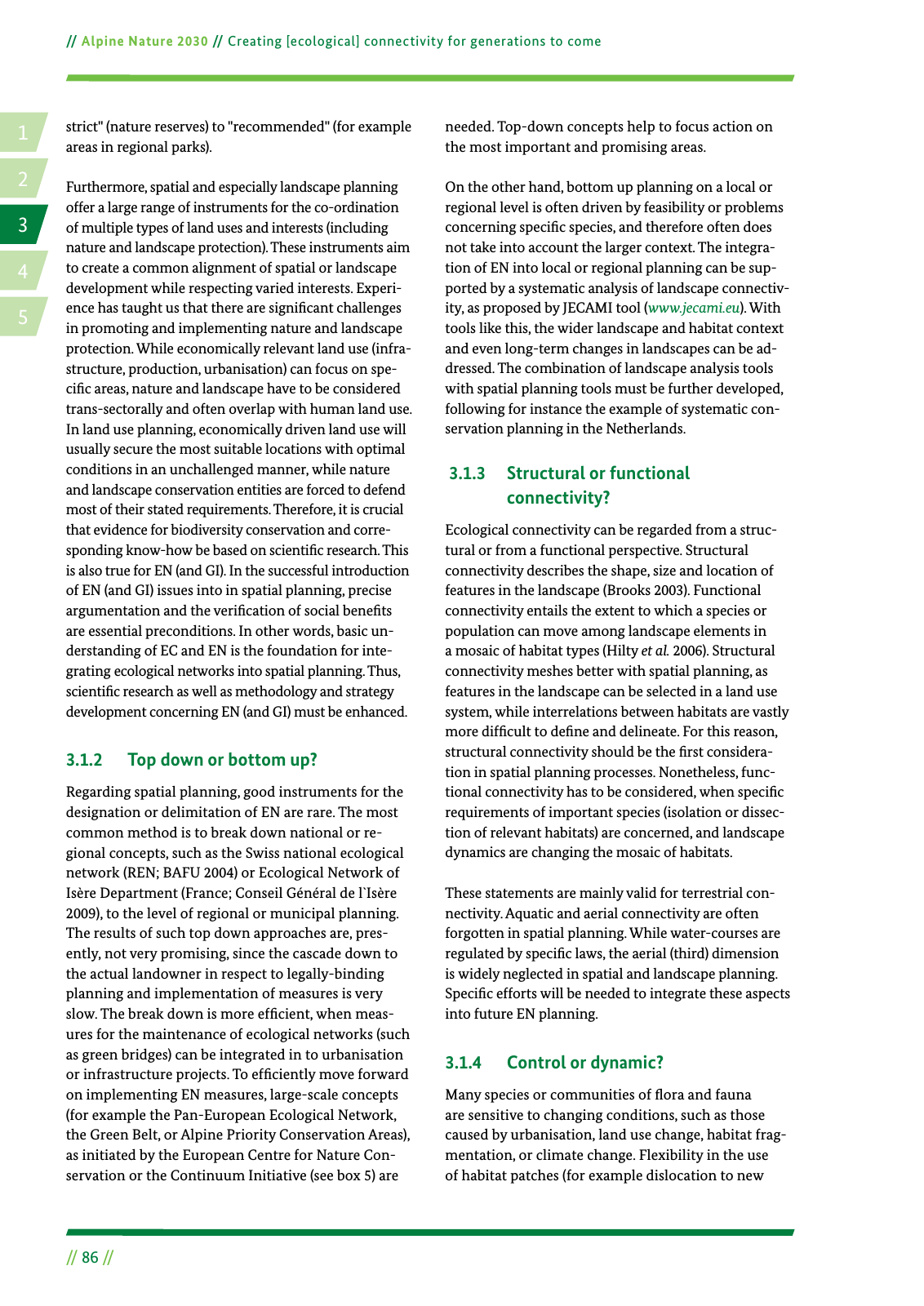14 2 5 3 Alpine Nature 2030 Creating ecological connectivity for generations to come 86 strict nature reserves to recommended for example areas in regional parks Furthermore spatial and especially landscape planning offer a large range of instruments for the co ordination of multiple types of land uses and interests including nature and landscape protection These instruments aim to create a common alignment of spatial or landscape development while respecting varied interests Experi ence has taught us that there are signi cant challenges in promoting and implementing nature and landscape protection While economically relevant land use infra structure production urbanisation can focus on spe ci c areas nature and landscape have to be considered trans sectorally and often overlap with human land use In land use planning economically driven land use will usually secure the most suitable locations with optimal conditions in an unchallenged manner while nature and landscape conservation entities are forced to defend most of their stated requirements Therefore it is crucial that evidence for biodiversity conservation and corre sponding know how be based on scienti c research This is also true for EN and GI In the successful introduction of EN and GI issues into in spatial planning precise argumentation and the veri cation of social bene ts are essential preconditions In other words basic un derstanding of EC and EN is the foundation for inte grating ecological networks into spatial planning Thus scienti c research as well as methodology and strategy development concerning EN and GI must be enhanced 3 1 2 Top down or bottom up Regarding spatial planning good instruments for the designation or delimitation of EN are rare The most common method is to break down national or re gional concepts such as the Swiss national ecological network REN BAFU 2004 or Ecological Network of Isère Department France Conseil Général de l Isère 2009 to the level of regional or municipal planning The results of such top down approaches are pres ently not very promising since the cascade down to the actual landowner in respect to legally binding planning and implementation of measures is very slow The break down is more ef cient when meas ures for the maintenance of ecological networks such as green bridges can be integrated in to urbanisation or infrastructure projects To ef ciently move forward on implementing EN measures large scale concepts for example the Pan European Ecological Network the Green Belt or Alpine Priority Conservation Areas as initiated by the European Centre for Nature Con servation or the Continuum Initiative see box 5 are needed Top down concepts help to focus action on the most important and promising areas On the other hand bottom up planning on a local or regional level is often driven by feasibility or problems concerning speci c species and therefore often does not take into account the larger context The integra tion of EN into local or regional planning can be sup ported by a systematic analysis of landscape connectiv ity as proposed by JECAMI tool www jecami eu With tools like this the wider landscape and habitat context and even long term changes in landscapes can be ad dressed The combination of landscape analysis tools with spatial planning tools must be further developed following for instance the example of systematic con servation planning in the Netherlands 3 1 3 Structural or functional connectivity Ecological connectivity can be regarded from a struc tural or from a functional perspective Structural connectivity describes the shape size and location of features in the landscape Brooks 2003 Functional connectivity entails the extent to which a species or population can move among landscape elements in a mosaic of habitat types Hilty et al 2006 Structural connectivity meshes better with spatial planning as features in the landscape can be selected in a land use system while interrelations between habitats are vastly more dif cult to de ne and delineate For this reason structural connectivity should be the rst considera tion in spatial planning processes Nonetheless func tional connectivity has to be considered when speci c requirements of important species isolation or dissec tion of relevant habitats are concerned and landscape dynamics are changing the mosaic of habitats These statements are mainly valid for terrestrial con nectivity Aquatic and aerial connectivity are often forgotten in spatial planning While water courses are regulated by speci c laws the aerial third dimension is widely neglected in spatial and landscape planning Speci c efforts will be needed to integrate these aspects into future EN planning 3 1 4 Control or dynamic Many species or communities of ora and fauna are sensitive to changing conditions such as those caused by urbanisation land use change habitat frag mentation or climate change Flexibility in the use of habitat patches for example dislocation to new

Hinweis: Dies ist eine maschinenlesbare No-Flash Ansicht.
Klicken Sie hier um zur Online-Version zu gelangen.
Klicken Sie hier um zur Online-Version zu gelangen.